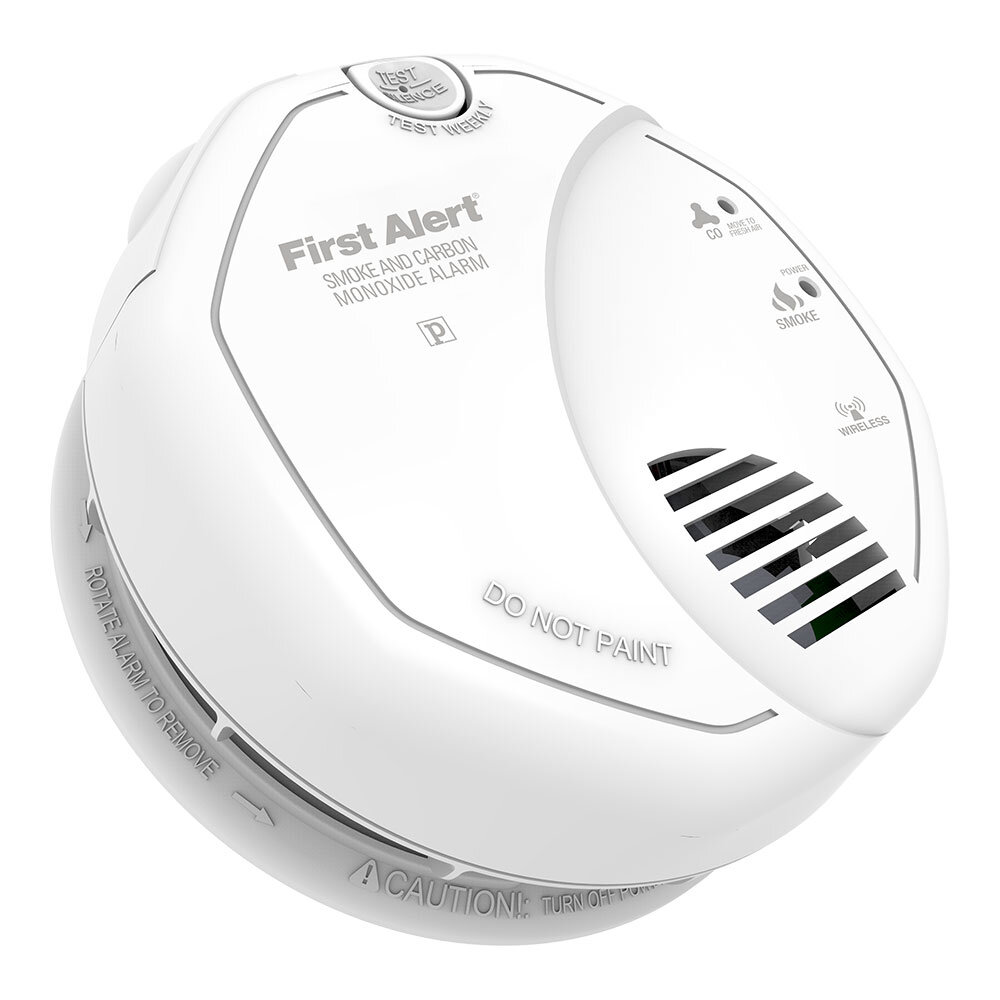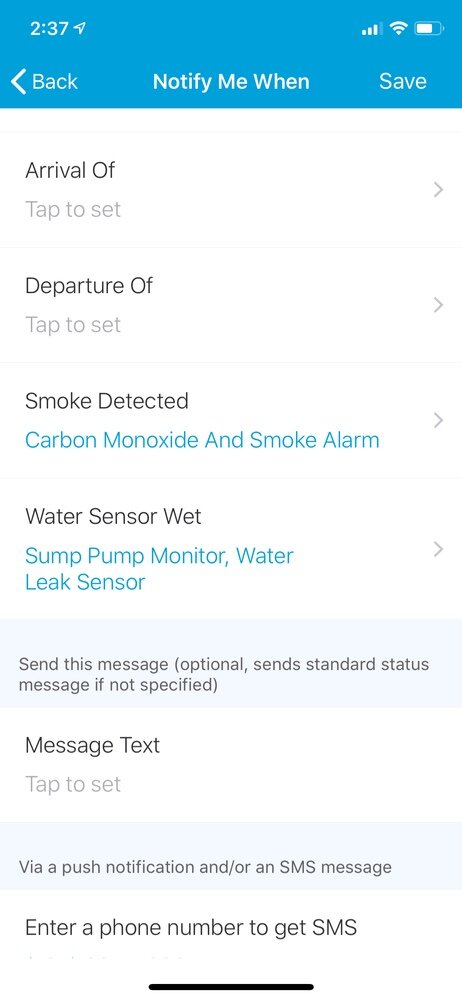First Alert Z-Wave Smoke Detector: Review
When you buy through links in this article, I may earn an affiliate commission. Learn More.
Every home should have a least one smoke detector, and likely more than that to ensure the occupants have enough time to escape in the event of a fire during the night. Smoke alarm maker First Alert has been a staple in this industry for many years and have embraced the smart home in the more recent product as well.
Smart home integration offers a number of benefits, such as being able to monitor the alarm status when you’re away and using it to trigger automated responses such as integrating smoke detectors with light bulbs and unlocking doors in the event of a fire.
Among the First Alert 2-in-1 smart offerings is the battery powered 2nd Gen Z-Wave Combo. This combines the smoke alarm with a carbon monoxide sensor as well, also a must have for any home using gas appliances. This device offers an affordable connected alarm with a good pedigree of reliability. If you haven’t looked at getting Z-wave yet, here are our recommendations for Z-Wave hubs. Now, let’s take a look at the details.
First Alert Z-Wave Combo
✔ Z-Wave Plus
✔ Certified for SmartThings, Ring Alarm, and Nexia
✔ Photoelectric Smoke Sensor
✔ CO Sensor
✔ Battery Powered, no wiring
✘ No Wi-Fi
✘ 7-year sensor life
Up Front Considerations
Interconnected Smoke Alarms
A useful feature of many connected smoke alarms, like First Alert’s own SC7010BV, is that they are able to link together (interconnect) so that if one goes off, they all do. This enhances the safety of the system by ensuring all members of the house are woken together regardless of where the smoke is detected. This obviously works best with multiple alarms in key areas.
While the First Alert Z-Wave Combo can do this through smart home automation, they don’t link together themselves, so you’ll need to take care of that using whatever Z-Wave hub you use.
Communication Protocol
Smart devices use different methods of communication, any many support more than one for better compatibility with other devices. The Z-Wave Combo alarm only supports Z-Wave, in fact Z-Wave Plus which gives it better security and easier pairing than older models. This keeps the cost down, but if you want to connect to another system you’ll need to look elsewhere.
Carbon monoxide sensors?
Any home that makes use of burning materials for heat or power should really have carbon monoxide detectors. Carbon monoxide is a silent killer as it accumulates in the bloodstream and blocks the carrying of oxygen. This can be produced in the home through burning of gas, wood, oil, kerosene and other fuels.
It’s becoming more common to include carbon monoxide alarms with Smoke detectors, and it’s a modest cost for greater protection.
Installation and Setup
SmartThings Alert Setup
The packaging is a bit bare bones, but comes with everything you’ll need for a quick install. This includes the alarm itself, a ceiling bracket and mounting screws, and the 2 AA batteries that power it.
Installation was a piece of cake. Turning it on involved pushing the battery compartment closed and testing it out. It worked and it is loud! The alarm is rated to 85dB. Mounting it was easy with the provided mounting bracket and screws that work just like every other smoke alarm I have ever seen.
I opted to set it up in SmartThings, although any Z-Wave Plus controller should work. Adding the alarm to your smart network involves closing the battery compartment while depressing the test button. This put it into pairing mode, and the SmartThings app recognized it and paired with it right away. You can see the status of the alarm and track the battery level right in the app.
I then setup a “notify me” home automation in the smart things app to send me alerts via text message when the alarm goes off. This will be convenient in case the alarm trips and I am not home. Peace of mind comes from knowing that everything is OK at home while you are away.
First Alert Features
Smoke and Carbon Monoxide Alarm
The key part of the device is based on well proven technology from First Alert’s staple product line. The smoke sensor is a photoelectric type, which helps reduce nuisance alarms from cooking, steam, and other normal activities. The second part detects carbon monoxide leaks, such as can result from gas lines which can be a silent killer.
Both the smoke and CO sensors will trigger the alarm in the same way, with each illuminating the corresponding LED on the face of the alarm. Note this is distinct from a carbon DIOXIDE alarm as that is related more to air quality than an immediate risk to the occupants of the home.
The alarm itself is a fairly loud 85dB. While less than a burglar alarm it’s fairly standard for smoke detectors which are trying to get your attention, not scare you off.
The sensors are rated for 7 years, which is a little less than some higher priced models which often offer 10 years. Of course, at this price it’s not a huge downside to replace them after that long.
Z-Wave Integration
The Z-Wave Plus connectivity is the other major selling point here. This makes adding the device to your network easier as you can use the QR code on the bottom to aid in the inclusion process. The Combo alarm only uses the Basic command class which doesn’t define any specific functionality. As such you’ll want to check if your Z-Wave controller supports these properly or you may have limited functionality.
Vera and SmartThings are known to work well, and the Ring Alarm also provides good support, including triggering monitored alarm services. Ring Alarm is not a full smart home platform though, so you won’t be able to trigger other smoke alarms from this one. The other platforms can do this through automation rules, as well as triggering other automated functions as desired.
Battery Powered
If you don’t have hard wiring for a smoke alarm in place already, going battery powered can save a lot of cost and headaches. With modern alarms, the battery life is decent, and you’ll be notified if you need to change them. It’s good practice to do it every year just to be safe, though.
First Alert rates the battery life at 3 years. This will, of course, depend on the type of batteries you use. Out of the box people are reporting varied experiences, between one and three. However, from my real world usage over a couple of years now I have been getting closer to one year – maybe I need to buy better batteries! (You can monitor the battery level in the SmartThings app).
The battery compartment is located on the side of the alarm, which actually aids in battery replacement, although the whole unit comes away from the mounting bracket with a twist, as is typical of other models.
Alternatives
Fibaro Smoke Sensor
✔ Z-Wave and Alexa support
✔ Optical Smoke Sensor
✔ Temperature sensor
✔ Battery Powered (CR123A)
✔ Adjustable sensitivity
✘ No CO sensor
European Z-Wave device maker Fibaro has their newest smoke detector out now in a stylish compact form factor. This is a pure Z-Wave device with adjustable smoke sensitivity (one of three levels). It uses an optical sensor, which is more prone to triggering from things like dust and steam, so this is probably a good thing.
Note that while Fibaro claims Alexa support, this is provided via the Z-Wave controller’s Alexa integration rather than natively on the device as it doesn’t have WiFi.
Although there is no CO sensor on this one, it optionally supports using a temperature threshold trigger in addition to smoke to detect fires, using it’s onboard temperature sensor.
OneLink Smoke and Carbon Monoxide Detector
✔ Supports Alexa and HomeKit
✔ Wi-Fi, no hub required
✔ 10 year Photoelectric Smoke Sensor
✔ CO Sensor
✔ Battery Backup
✔ Supports interconnect
✘ Wired power required
✘ Onelink app not great
If you’re after something other than Z-Wave, First Alert offers their OneLink range which supports Amazon Alexa and Apple HomeKit over Wi-Fi instead of Z-Wave. These models are hard wired as Wi-Fi uses a lot more power, but you get a 10-year sensor life, and battery backup so you won’t need to worry about changing them over its life.
There are quite a few complaints about the OneLink app itself, mostly around the initial setup process. The device uses Bluetooth for initial configuration, which has tripped some people up as it’s not mentioned, and they moved too far away. Once you’re on the network though, it’s not an issue.
The Verdict
There aren’t actually a great many reputable smoke alarms around that support Z-Wave. First Alert offers a solid, if minimalist, option that works well and has the added bonus of being fully supported by Ring’s Alarm system.
I really couldn’t be happier about this smart battery-powered combination smoke alarm. The price was fair, it was easy to install and integrate, and it works as advertised.










